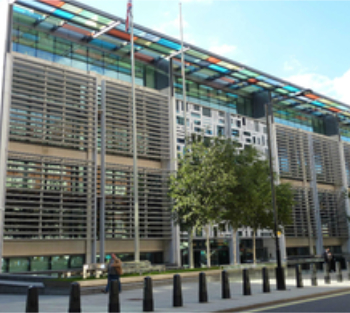The thermal behaviour of spaces enclosed by fabric membranes
A thesis submitted to the University of Wales for the degree of Philosophiae Doctor by GREGOR HARVIE. Welsh School of Architecture, University of Wales College of Cardiff, March 1996.
The findings in brief:
- Boundary models and CFD models need to be dynamically linked to properly represent the impact of thin boundaries whose temperatures can change very rapidly and very significantly (up to 15°c in a minute simply as a result of the sun coming out).
- Analysis of comfort must include radiant temperatures as well as air temperatures, particularly in spaces where there is a significant difference in temperature between the air in the space and the surfaces enclosing it, or where solar radiation penetrates the space.
- The difference in temperature between thin boundaries and the air they enclose, combined with smooth surface geometry results in a higher surface air velocity than is found in conventional spaces. This is similar to the downdraft generated by a cold window.
- Where there is likely to be a significant difference in temperature between a boundary and the air adjacent to it, a very small cell size (40 mm or less) is required to properly simulate the increased surface air velocity at that surface and so the increased surface heat transfer. Failure to properly simulate this will result in an underestimation of the contribution the boundary makes to internal conditions.
- In non-cartesian spaces (i.e. where surfaces are not all vertical or horizontal, but may be inclined or curved) it is necessary to use a body-fitted cell grid (i.e. one in which the grid is distorted to follow the contours of the surface) to allow a small enough cell size adjacent to boundaries to properly simulate the flow of air across those boundaries. If a cartesian grid is used, a refined grid is required throughout the space just to simulate the flow of air across the non-cartesian boundaries and this is computationally impractical.
 This thesis describes a programme of research the aim of which was to investigate the thermal behaviour of spaces enclosed by fabric membrane envelopes.
This thesis describes a programme of research the aim of which was to investigate the thermal behaviour of spaces enclosed by fabric membrane envelopes.
Initial analysis suggested that a fabric membrane can affect conditions within a space enclosed by it as a result of its internal surface temperature and the amount of radiation it directs into that space. In order to investigate these parameters, a test cell was constructed which allowed the thermal behaviour of a range of fabric membranes to be monitored.
The monitored data revealed that the thermal behaviour of fabric membranes is entirely dictated by their angular thermal optical properties. These properties were measured and a dynamic spread sheet model was developed which was able to simulate the monitored behaviour fairly accurately.
In order to investigate the thermal behaviour of spaces enclosed by such membranes, conditions within four existing fabric roofed buildings were monitored. The monitored data revealed that comfort temperatures could vary significantly from place to place within such spaces. These variations were produced by both the stratification of internal air temperatures and differences in internal radiant temperatures.
An attempt was made to simulate the behaviour of the buildings monitored, using a general applications CFD code in conjunction with information generated by the spread sheet model. Whilst some behaviour patterns could be simulated accurately using this approach, it was apparent that the simplification of boundary conditions in the CFD code meant it was unable to accurately predict strong internal stratification.
It was proposed that improving the reliability of this process would require the development of a specialist CFD model able to dynamically simulate both the behaviour of the fabric enclosure and the internal space.
- File:Contents.pdf. Contents.
- File:Chapter 1.pdf. Introduction.
- File:Chapter 2.pdf. Subject Background.
- File:Chapter 3.pdf. The Existing Body of Knowledge.
- File:Chapter 4.pdf. Methodology.
- File:Chapter 5.pdf. Monitoring the Thermal Behaviour of Fabric Membranes.
- File:Chapter 6.pdf. Measuring the Thermal Properties of Fabric Membranes.
- File:Chapter 7.pdf. Modelling the Thermal Behaviour of Fabric Membranes.
- File:Chapter 8.pdf. Monitoring the Thermal Behaviour of Spaces Enclosed by Fabric Membranes.
- File:Chapter 9.pdf. Modelling the Thermal Behaviour of Spaces Enclosed by Fabric Membranes.
- File:Chapter 10.pdf. Discussion.
- File:Chapter 11.pdf. Conclusions.
- File:Appendices.pdf. Appendices.
--Gregor Harvie 05:36, 22 May 2014 (BST)
[edit] Related articles on Designing Buildings Wiki
- Architectural fabrics.
- Computational Fluid Dynamics.
- Computational fluid dynamics in building design: An introduction FB 69.
- Dynamic façade.
- ETFE.
- Fabric structures.
- Frei Otto.
- Integrating CFD into the design process.
- Khan Shatyr Entertainment Centre.
- Millennium Dome.
- Sustainability.
- The building as climate modifier.
- The history of fabric structures.
- The structural behaviour of architectural fabric structures.
- Thermal behaviour of architectural fabric structures (updated version of this research).
- Thermal comfort.
- Transparent insulation materials.
- U values.
Featured articles and news
Shortage of high-quality data threatening the AI boom
And other fundamental issues highlighted by the Open Data Institute.
Data centres top the list of growth opportunities
In robust, yet heterogenous world BACS market.
Increased funding for BSR announced
Within plans for next generation of new towns.
New Towns Taskforce interim policy statement
With initial reactions to the 6 month policy update.
Heritage, industry and slavery
Interpretation must tell the story accurately.
PM announces Building safety and fire move to MHCLG
Following recommendations of the Grenfell Inquiry report.
Conserving the ruins of a great Elizabethan country house.
BSRIA European air conditioning market update 2024
Highs, lows and discrepancy rates in the annual demand.
50 years celebrating the ECA Apprenticeship Awards
As SMEs say the 10 years of the Apprenticeship Levy has failed them.
Nominations sought for CIOB awards
Celebrating construction excellence in Ireland and Northern Ireland.
EPC consultation in context: NCM, SAP, SBEM and HEM
One week to respond to the consultation on reforms to the Energy Performance of Buildings framework.
CIAT Celebrates 60 years of Architectural Technology
Find out more #CIAT60 social media takeover.
The BPF urges Chancellor for additional BSR resources
To remove barriers and bottlenecks which delay projects.
Flexibility over requirements to boost apprentice numbers
English, maths and minimumun duration requirements reduced for a 10,000 gain.
A long term view on European heating markets
BSRIA HVAC 2032 Study.
Humidity resilience strategies for home design
Frequency of extreme humidity events is increasing.
National Apprenticeship Week 2025
Skills for life : 10-16 February


























Comments
To start a discussion about this article, click 'Add a comment' above and add your thoughts to this discussion page.